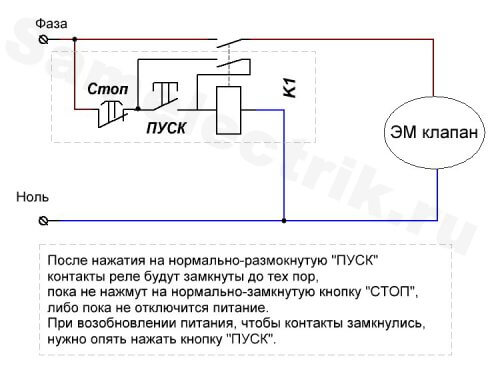How to make automatic shutdown with manual activation of the gas valve?
I bought her a gas solenoid valve, installed it on the gas supply pipe and from it to the boiler. Everything works, off the outlet, it works and cuts off the gas supply, so the flame goes out all is well. But when it is turned on, it is turned on and gas is supplied and the boiler is out and even as there is no automation in the boiler, the gas does not ignite and does not overlap in the boiler and goes simply into the chimney, which is dangerous and costly. What now I need, I need a certain device that will turn off the current supply to the electromagnetic valve if the electricity in the network is suddenly cut off. It is necessary that it manually turns on the current supply to the solenoid valve. Something like a circuit breaker if electricity was lost in it but did not short-circuit it when electricity appeared in the circuit, but it was necessary to turn it on manually, such as a light switch. Sorry for the confusion, I can not formulate the question more precisely.
good afternoon
A simple option is to put the undervoltage release to the machine, and connect the valve through a low-power machine.
A difficult option is to find a polarized relay. It works when a voltage of a certain polarity is applied.
There are also such devices as indicator relays, or, as they are also called "Blinker" - they work and until you return them to their original position with their hands - they do not supply voltage to the circuit.
And finally, the correct and classic option is a relay or a starter with a self-pickup. The starter for the valve is redundant, but the relay is what you need. For this you need a relay with two groups of normally open contacts with a 220V coil. I enclose the scheme.
To choose the suitable one, as an option, you can look at the catalog of the Finder company or any others. If you do not find it with a 220V coil, then take it to 12V, you can even two automotive relays connected in parallel, the circuit itself will not change much.
Buttons also need 2 “stop” normally closed (contacts are closed when you do not press it), and “start” normally open (like a doorbell). But in fact, “stop” you do not really need. Only if you just put out the boiler, but you can do it with a plug and just pull it out of the socket. If the power of the relay allows, then you can connect the valve with the pump to it. Look at the current.




Thanks for the detailed answer. As for the release of the min of voltage, does it work from a complete disconnection of the voltage and is it not clear about the low-power automatic device for the valve?
Well, the undervoltage release is always connected to the machine, that is, either put the general machine on the pump and valve, or only on the valve, because initially it was discussed.
Yes, it should work. But a self-locking relay is more reliable.